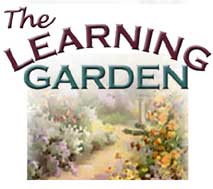| |
E. Helpful Hints
For those of you embarking upon a school gardening adventure for the
first time and for those seasoned school gardeners looking for a fresh
approach, here are some helpful hints to make your school gardening experiences
affordable, simple, and fun:
If you are short on supplies or funding, you have several options:
- Send a letter home to parents requesting such things as milk cartons
(waxed cardboard kind) or yogurt containers for use as pots. Almost
any container will work. Students can learn about recycling and have
fun decorating their own "pots" for use in experiments.
- Use a plastic bag inside a wastebasket for mixing soil.
- Students can create their own potting and plant labels by cutting
plastic yogurt and milk containers into strips and writing on them with
permanent marker.
- Instead of growing plants under fluorescent lights, grow them on
a sunny windowsill. This alternative is not as effective, but it will
work.
- Inquire whether a local gardening shop would be willing to donate
or provide discounts on other supplies (e.g., seeds, soil, tools).
- Grow your own compost! See Activity
42: Magical Microbes.
- Generate revenue by having a plant sale with the plants or products
that you grow in the classroom or garden. This money can be set aside
to purchase additional gardening supplies.
- Plan to use the same plants for more than one lesson or activity.
For example, use the same plants for lessons on germination, plant growth,
and photosynthesis.
If you are feeling overwhelmed by the thought of adding or maintaining
a gardening component-relax! The responsibility need not fall on your
shoulders alone.
- Consult with other teachers in the school to see if you can accomplish
the task in a collaborative way. This collaboration has the added benefit
of exposing more students to plants and gardening.
- Make "responsibility cards." Hand these cards out to students daily
or weekly. On the cards, include a plant task (watering, pruning, etc.)
as well as the necessary instructions to complete the task. In this
way, students are taking on some of the responsibility while learning
about the requirements that plants have.
Let's get started... Good luck!
|
|

